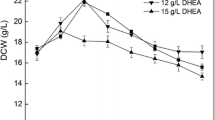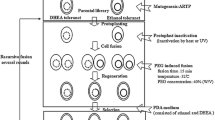Abstract
7α,15α-diOH-DHEA is a key precursor of the novel oral contraceptive Yasmin. Colletotrichum lini could catalyze dehydroepiandrosterone (DHEA) at the 7α and 15α positions. In this work, C. lini resting cells were applied in the bioconversion of DHEA to 7α,15α-diOH-DHEA. In the presence of 2 % (w/v) Tween-80, the conversion efficiency of DHEA increased drastically. The DHEA conversion and the 7α,15α-diOH-DHEA yield increased by 34.6 and 87.0 %, respectively, at the DHEA concentration of 10 g/L. Furthermore, the effects of Tween-80 on substrate solubility and C. lini physiological properties were studied. Results showed that the DHEA solubility with 2 % Tween-80 increased by 7.8 times. Meanwhile, the mycelia were integrated and full in the presence of 2 % Tween-80. The analysis on fatty acid profile of the C. lini cell membrane indicated that Tween-80 increases the content of unsaturated fatty acid. All above results suggested that the enhanced product yield caused by Tween-80 was mainly associated with easier substrate-molecule transportation across the cell membrane of C. lini.




Similar content being viewed by others
References
Maser, E., & Rizner, T. L. (2012). Steroids and microorganisms. Journal of Steroid Biochemistry and Molecular Biology, 129, 1–3.
Woodley, J. M. (2008). New opportunities for biocatalysis: making pharmaceutical processes greener. Trends in Biotechnology, 26, 321–327.
Donova, M. V. (2007). Transformation of steroids by actinobacteria: a review. Applied Biochemistry and Microbiology, 43, 1–14.
Donova, M. V., & Egorova, O. V. (2012). Microbial steroid transformations: current state and prospects. Applied Microbiology and Biotechnology, 94, 1423–1447.
Kristan, K., & Rizner, T. L. (2012). Steroid-transforming enzymes in fungi. Journal of Steroid Biochemistry and Molecular Biology, 129, 79–91.
Janeczko, T., Gładysz, J. D., Susłow, E. K., Białonska, A., & Ciunik, Z. (2009). Biotransformations of steroid compounds by Chaetomium sp. KCH 6651. Steroids, 74, 657–661.
Zhang, S., Liu, P. H., Zhao, L., & Liu, X. L. (2014). Hydroxylation of dehydroepiandrosterone by Penicillium decumbens ph-13. Lecture Notes in Electrical Engineering, 251, 1393–1398.
Lobastova, T. G., Gulevskaya, S. A., Sukhodolskaya, G. V., & Donova, M. V. (2009). Dihydroxylation of dehydroepiandrosterone in positions 7α and 15α by mycelial fungi. Applied Biochemistry and Microbiology, 45, 617–622.
Li, H., Fu, Z. Z., Zhang, X. M., Li, H., Shi, J. S., & Xu, Z. H. (2014). The efficient production of 3β,7α,15α-trihydroxy-5-androsten-17-one from dehydroepiandrosterone by Gibberella intermedia. Applied Biochemistry and Biotechnology, 174, 2960–2971.
Grishko, V. V., Tarasova, E. V., & Ivshina, I. B. (2013). Biotransformation of betulin to betulone by growing and resting cells of the actinobacterium Rhodococcus rhodochrous IEGM 66. Process Biochemistry, 48, 1640–1644.
Li, X. F., Jiang, B., & Pan, B. L. (2007). Biotransformation of phenylpyruvic acid to phenyllactic acid by growing and resting cells of a Lactobacillus sp. Biotechnology Letters, 29, 593–597.
Goetschel, R., & Bar, R. (1992). Formation of mixed crystals in microbial conversion of sterols and steroids. Enzyme and Microbial Technology, 14, 462–469.
Marques, M. P. C., Carvalho, F., Magalhães, S., Cabral, J. M. S., & Fernandes, P. (2009). Screening for suitable solvents as substrate carriers for the microbial side-chain cleavage of sitosterol using microtitre plates. Process Biochemistry, 44, 556–561.
Zehentgruber, D., Dragan, C. A., Bureik, M., & Lutz, S. (2010). Challenges of steroid biotransformation with human cytochrome P450 monooxygenase CYP21 using resting cells of recombinant Schizosaccharomyces pombe. Journal of Biotechnology, 146, 179–185.
Folch, J., Lees, M., & Sloane-stanley, G. H. (1957). A simple method for the isolation and purification of total lipids from animal tissues. Journal of Biological Chemistry, 19, 145–149.
Romano, A., Romano, D., Ragg, E., Costantino, F., Lenna, R., Gandolfi, R., & Molinari, F. (2006). Steroid hydroxylations with Botryodiplodia malorum and Colletotrichum lini. Steroids, 71, 429–434.
Avramova, T., Spassova, D., Mutafov, S., Momchilova, S., Boyadjieva, L., Damyanova, B., & Angelova, B. (2010). Effect of Tween 80 on 9α-steroid hydroxylating activity and ultrastructural characteristics of Rhodococcus sp. cells. World Journal of Microbiology and Biotechnology, 26, 1009–1014.
Sheng, L., Zhu, G. L., & Tong, Q. Y. (2013). Mechanism study of Tween 80 enhancing the pullulan production by Aureobasidium pullulans. Carbohydrate Polymers, 97, 121–123.
Zhang, B. B., Chen, L., & Cheung, P. C. K. (2012). Two-dimensional gel electrophoresis analysis of mycelial cells treated with Tween 80: differentially expressed protein related to enhanced metabolite production. Journal of Agricultural and Food Chemistry, 60, 10585–10591.
Acknowledgments
This work is financially supported by the National High-Tech R&D Program (No. 2011AA02A211), the National Natural Science Foundation of China (No. 31300026), and the Natural Science Foundation of Jiangsu Province (No. BK2012117).
Author information
Authors and Affiliations
Corresponding author
Additional information
Hui Li and Siqi Yin have equal contributions to this work.
Rights and permissions
About this article
Cite this article
Li, H., Yin, S., Zhang, X. et al. Enhanced 3β,7α,15α-Trihydroxy-5-Androsten-17-One Production from Dehydroepiandrosterone by Colletotrichum lini ST-1 Resting Cells with Tween-80. Appl Biochem Biotechnol 178, 91–100 (2016). https://doi.org/10.1007/s12010-015-1860-3
Received:
Accepted:
Published:
Issue Date:
DOI: https://doi.org/10.1007/s12010-015-1860-3




